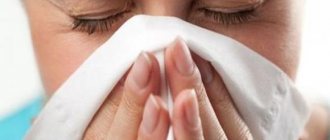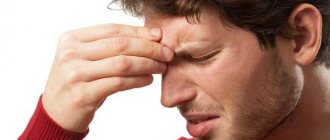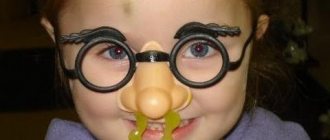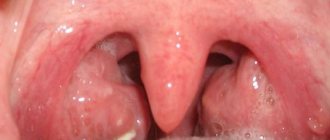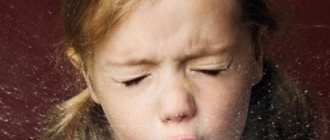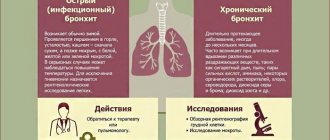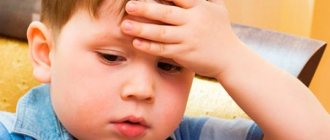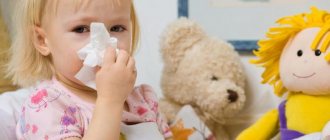A runny nose is a frequent guest in families where children grow up. Everyone knows that nasal congestion is not an independent disease, it is only a symptom. Moreover, he can talk about a wide variety of diseases. However, in most families, mothers and fathers continue to treat their child for a runny nose. This therapy is sometimes long-term. The famous children's doctor Evgeny Komarovsky tells what a runny nose “signals” to adults, and what parents should do so that their child can breathe easily and simply.
About the problem
Even the most caring mother, who takes care of and protects her child from everything in the world, will not be able to ensure that her child never gets a runny nose in his life. This is because rhinitis (the medical name for the runny nose) most often occurs during acute viral respiratory infections. At the physiological level, the following happens: one of the many viruses that always surround the child gets onto the nasal mucosa. In response, the immune system gives the command to secrete as much mucus as possible, which should isolate the virus from other organs and systems, preventing it from moving further through the nasopharynx, larynx, bronchi and lungs.
In addition to the viral form, which accounts for about 90% of all cases of children's runny nose, according to Evgeniy Komarovsky, rhinitis can be bacterial. This causes pathogenic bacteria to enter the nasal cavity. The body reacts in a similar way - with increased mucus production. Bacterial rhinitis itself is extremely rare, and its course is always very severe. Bacteria (most often staphylococci) cause severe inflammation, suppuration, and toxic waste products cause general intoxication.
Sometimes a bacterial runny nose can develop after a child has suffered a viral infection. This happens because accumulated mucus in the nasal passages becomes an excellent breeding ground for bacteria.
Usually these bacteria are harmless; they live in the nose and mouth on a permanent basis and do not bother the child in any way. However, in conditions of an abundance of mucus, its stagnation, drying out, microbes become pathogenic and begin to multiply rapidly. This usually happens with complicated rhinitis.
The third, fairly common cause of runny nose in children is allergies. Allergic rhinitis occurs as a reaction of local immunity to a protein antigen. If such a substance enters the body, the nasal mucosa reacts with swelling, making it difficult for the child to breathe through the nose.
In some cases, nasal congestion and impaired nasal breathing are associated with ENT diseases, such as adenoids . If the runny nose is acute (occurred no earlier than 5 days ago), then there should be no reason for special concern. In case of persistent snot and other symptoms, it is better to consult an otolaryngologist.
Treatment of viral runny nose
Viral rhinitis is the most common among children and does not require treatment as such. The mucus produced by the membranes of the nose contains special substances that are very important for fighting the virus that has entered the body. However, the beneficial properties of mucus will end immediately after the snot becomes thick. As long as they flow, everything is fine, parents can calm down.
But if suddenly the nasal mucus thickens, becomes green, yellow, yellow-green, purulent, purulent with impurities of blood, it ceases to be a “fighter” against the virus and becomes an excellent breeding ground for bacteria. This is how a bacterial runny nose begins, which will require treatment with antibiotics.
Thus, with a viral runny nose, the main task of parents is to prevent the mucus in the nose from drying out. The snot should remain liquid. That’s why Evgeniy Komarovsky recommends not looking for pharmacy magic nose drops, because there are no cures for viruses, but simply rinsing the child’s nasal cavity with saline solutions, and doing this as often as possible (at least every half hour). To prepare the solution, you need to take a teaspoon of salt per liter container of boiled chilled water. The resulting solution can be dripped, washed out of the nose using a disposable syringe without a needle, or sprayed with a special bottle.
For instillation, you can use other means that help thin the nasal mucus - “Pinosol”, “Ectericide”. Washing with the most common saline solution, which can be bought inexpensively at any pharmacy, effectively thins snot.
Snot or runny nose in children is most often caused by three main reasons: viruses, bacteria or allergies .
Causes of children's snot
Among viruses, rhinovirus is usually the cause of snot. There are more than a hundred varieties of this virus. The source of infection is sick children or healthy virus carriers. In autumn and winter, the disease occurs in the form of epidemics.
Almost all children, except babies under 6 months , are susceptible to subtypes of this virus, especially in conditions of close contact in a group.
The disease begins acutely with high body temperature and burning in the nose. After a few days, a bacterial infection occurs and the child’s runny nose takes on a green tint.
If in the first days of illness a nasal swab is performed on a child, a large accumulation of lymphocytes will be observed in it, which confirms the diagnosis of a viral infection.
Often, a smear can detect the presence of staphylococcus in a baby’s nose. This bacterium can normally live in the nasal cavity and oropharynx of a small patient. It is highly resistant to antimicrobial drugs, making it difficult to respond to conventional treatment regimens.
When immunity decreases due to a viral infection, staphylococcus begins to actively multiply on the nasal mucosa, causing new symptoms of the disease. When bacteria multiply, active substances are released from the cells of the immune system, which leads to snot turning green.
Allergic rhinitis in children is manifested by clear discharge. Allergies in children are usually caused by dust, fur and epidermis of pets, and pollen of certain plants and trees.
Often, drug allergies develop to vasoconstrictors and other nasal products, with which parents unsuccessfully try to treat allergic rhinitis. The addition of a bacterial infection to an allergic rhinitis is also manifested by green snot in a child.
Green snot does not always require antibiotics or other treatments. They are often associated with excessive dryness of the nasal cavity and can be eliminated by simply humidifying the room or irrigating the nasopharynx with saline solutions.
Frequent walks with your child in a park or forest away from busy roads will help cope with this problem without the use of medications.
Approaches to treating snot in a child and the need to consult a doctor
Some parents consider the presence of snot or a common cold in their children not a reason to see a doctor; they begin treating the child with folk remedies or do nothing.
A consultation with a doctor is necessary at least in order to determine whether treatment is needed in this case or whether the little patient’s body will cope on its own.
However, if a child suffers from a runny nose more than 2-3 times a year, then seeing a doctor every time can be problematic, so parents should learn first aid methods for a child with a runny nose:
Cleansing and moisturizing the nasal mucosa with saline solutions.
You can buy it at the pharmacy or make it yourself (a teaspoon of salt per liter of water).
The use of vasoconstrictor drops.
In case of severe swelling in the nose, no more than 5–7 days ( Nazol baby, Sanorin, etc.).
For green snot, you can use antibacterial nasal drops based on protargol, collargol or miramistin.
Plant-based drops ( sea buckthorn, thuja , etc.) are a safe, but no less effective way to relieve nasal congestion and get rid of a runny nose.
A runny nose can be treated without the use of medications - with the help of massage. How to do this, read the article: massage the nose for a runny nose.
If this treatment helps the baby, then you can cope with the problem at home. But there are several situations that Dr. Komarovsky often mentions when it is necessary to visit a doctor:
- If there is no improvement on the 4th day;
- The temperature continues to persist after seven days;
- There is no positive dynamics for 2-3 days and the child’s condition continues to deteriorate.
How and with what to thin the snot of a child and an adult: thinning nasal drops
In the treatment of inflammatory processes in the upper respiratory tract, snot thinners play a significant role. The choice of drugs is based on the etiology of the disease, severity and nature of the discharge produced. Secretomotor therapy is aimed at reducing the viscosity of nasal mucus and improving its outflow.
Poorly discharged nasal secretions act as catalysts for an unproductive cough, disruption of natural breathing, and the development of a chronic form of pathology and sinusitis. The doctor’s task is to identify and eliminate the source of the lesion, alleviate symptoms, and thin snot in adults and children. Positive dynamics can be achieved with the help of pharmaceutical products and traditional medicine recipes.
Why does the consistency and color of snot change?
Under favorable conditions, the body produces transparent mucus to moisturize the epithelium and protect against the penetration of pathogenic strains, antigens, and dust. The composition of muconasal secretion is represented by three main components: salt, water and mucin protein.
Under the influence of aggressive external and internal factors, active production of mucoproteins occurs, which are responsible for the concentration of snot.
Blocked airways are dangerous for infants who cannot breathe through their mouths.
The appearance of naturally colored, odorless mucus is associated with respiratory diseases, allergic reactions, and anatomical disorders. A change in color to a yellow or green tint indicates a bacterial etiology, a chronic form of rhinitis.
Thick green snot precedes recovery and indicates the death of leukocytes and pathogenic bacteria.
Interesting! With systematic abuse of tobacco products, nicotine tars settle on the inner membranes, turning the muconosal secretion brown.
The causes of viscosity include unfavorable indoor climate conditions, hypothermia, untimely or incorrect medical care.
Drugs that thin the mucus in the nose
Blowing your nose will not solve the problem of sticky mucus; an integrated approach is needed here. Treatment for thick snot begins with a visit to the doctor. Based on a visual examination and endoscopic examination, the doctor determines the nature of rhinitis and draws up a therapeutic regimen.
Mechanical cleansing of the nasal passages
You can thin thick snot with a saline solution. It is prepared at home: 250 ml. add 15 g of table salt to water, stir until the crystals are completely dissolved.
Irrigation of inflamed tissue should be carried out in a horizontal position, with the head tilted at an angle of 90°. Using a syringe without a needle or a medical bulb, the solution is injected into each nostril one by one. If the irrigation technique is followed, the remaining fluid flows freely through the opposite nasal canal.
Such hygiene procedures are allowed for adults and children over 4 years of age.
For patients under 3 years of age, a low concentration saline solution is used for instillation. 2-3 drops are carefully introduced into each nasal passage every 4 hours until complete recovery. At the end of the procedure, any remaining mucus is removed using aspirators, cotton swabs, or blowing your nose.
Important! The use of a saturated saline solution is fraught with drying out of the mucous membrane and the formation of crusts on the surface, which, when deformed, manifest as nosebleeds.
The line of pharmaceutical moisturizers is represented by Aquamaris, Salin, Aqualor, and the Dolphin system.
Salts and crystals of ocean water gently cleanse, saturate the epithelium with water, reduce swelling, and cleanse the sinuses of foreign agents. Medicinal sprays do not cause tachyphylaxis (addiction to medications), therefore they are used for an unlimited course.
The danger of blowing sticky snot is explained by the risk of damage to the eardrum, which is located at the junction of the nasal cavity with the middle ear.
What drops thin snot?
Drugs of the secretomotor group are designed to normalize breathing, facilitate the outflow of mucus, and relieve inflammation and swelling.
The composition of medicinal products is represented by herbal components and synthetic compounds that restore drainage function and activate the mucociliary apparatus.
For reference! The liquefying activity is provided by essential oils of eucalyptus, fir, anise, elderberry, marshmallow root, thyme, and primrose.
Mucolytic and secretolytic drugs provoke contraction of the bronchial muscles, increase the activity of the ciliated epithelium, and clear the nasal passages of mucus accumulation. They influence the rheological properties of muconasal secretion without increasing its volume.
The action of enzymes (trypsin, chymotrypsin) and chemicals (acetylcysteine, ambroxol) is aimed at normalizing the ratio of serous and mucous discharge, increasing the concentration of surfactant (an active substance that prevents the gluing of villi of the ciliated epithelium, promotes the removal of sputum).
Rinofluimucil
Rinofluimucil is an effective nasal drop that thins mucus. Under the influence of acetylcysteine, the viscosity of the secretion of the bronchial glands decreases, free sputum separation occurs, and an expectorant effect occurs.
Tuaminoheptane sulfate exhibits vasoconstrictor activity and eliminates hyperemia of the inner membrane.
The nasal cavity is irrigated with an aerosol, 2 doses into each opening at equal intervals up to 4 times a day. The children's norm is limited to one click three times a day, no more than 7 days.
The drug is prescribed to patients over 2 years of age. The advisability of using nasal drops during pregnancy and breastfeeding is determined by the doctor.
Sinuforte
Sinuforte has become widespread in ENT practice. A medicinal liquid of plant origin (based on cyclamen extract and juice) stimulates a reflex reaction, which is manifested by mucous secretions.
The result of dehydration is the normalization of the viscosity of the exudate, the creation of favorable conditions for the removal of serous discharge, and the improvement of ventilation of the paranasal sinuses.
The medication does not have an irritating effect. An exception would be increased sensitivity of the body to individual components.
Prescribed for adults and children over 12 years of age, 2-3 drops once for 6-8 days. The duration of the course increases to 15 days if nasal drops are prescribed every other day.
Mucin protein is responsible for increasing the concentration of snot
Antiviral drugs
When the cause of thick snot is a bacterial form of rhinitis, it is advisable to use pharmaceutical products based on interferon or polypeptide.
The active substances are active at the intercellular level and are effective in the initial stages of mucosal inflammation or for preventive purposes.
Intranasal preparations have antiviral activity:
- "Genferon";
- "Grippferon";
- "Laferon";
- "Nazoferon".
Medicines are included in the therapeutic regimen of children from the first days of life. Indications for use include infection of the upper respiratory tract, inflammation of the paranasal sinuses, acute respiratory viral infections, and preventing the risk of pneumonia.
The course and dosage is determined by the doctor, taking into account the physiological characteristics and medical history of the patient. It is not recommended to use the drug for longer than 5 days.
For reference! One of the oldest and most reliable antiviral agents is “Oxolinic ointment”. For therapeutic and preventive measures, the mucous membrane is treated with a thick substance 3-4 times a day.
Antihistamines for sticky snot
The release of thick white mucus is interpreted as a protest from the body to the presence of allergens. Potent antigens include:
- plant spores;
- household chemicals;
- pet hair;
- dust;
- tobacco smoke;
- harmful production conditions.
Combined antihistamine drops have a complex effect on the body: “Sanorin”, “Analergin”, “Alergodil S”, “Vibrocil”.
The group of sympathomimetics has a vasoconstrictor effect, normalizes blood flow to the mucous membrane, and blocks the actions of histamine H₁ receptors.
Patients with pathologies of the cardiovascular system, metabolic disorders, and blood pressure are recommended to limit contact with nasal medications. For children over 3 years old, instill 1 drop alternately every 4 hours, for adults 2-3 drops at the same frequency.
Inhalations
Thinning nasal drops for children are more effective when the medication is administered through a liquid spray. The procedure helps improve mucus discharge, restore nasal drainage, and reduce swelling.
The daily frequency of inhalations for an adult patient varies from 2 to 3; for children, one for 5-10 minutes is enough
You can carry out manipulations at home if you have a special device - an inhaler. The operating principle of the nebulizer is based on fine spraying. The therapeutic effect occurs faster than when using nasal sprays and allows you to treat the maximum area of the nasal cavity.
Nuance! It is recommended to inhale an hour before or after meals.
For a thick runny nose, use alkaline mineral waters “Borjomi”, “Essentuki”, “Narzan”. A cheaper, but no less effective option is saline solution.
Lazolvan, Fluimucil, Ambrobene, and ACC Inject are effective in treating the respiratory tract and liquefying sputum.
How and how to thin a child’s snot using folk remedies
Alternative medicine is used in combination with conservative methods. The essence of folk recipes is the formation of immune protection, epithelization of soft tissues, and a decrease in the viscosity of sputum.
The following manipulations can improve the discharge of adhesive secretions:
- Irrigation of the nasal sinuses with garlic or onion juice. The garden plant is crushed to a pasty state, the juice is filtered through cheesecloth, diluted with water in a ratio of 1:3. To improve the therapeutic effect, add an incomplete teaspoon of honey. Place 1-2 drops in each nostril for 10 days;
- aloe/kalanchoe. The nasal canals are irrigated alternately with freshly squeezed juice three times a day until complete recovery;
- cleansing the paranasal sinuses with herbal decoctions. A medicinal liquid is prepared from one component or a combination of several (chamomile, calendula, sage, coltsfoot);
- steam heating of the lower and upper extremities with the addition of eucalyptus oil or dry mustard powder. The procedure is performed at natural body temperature.
Phytoncides and essential oils in onions have an antimicrobial and antimycotic effect.
Moist air is a concomitant factor for rapid recovery. To normalize a favorable microclimate, it is necessary to ventilate the room every day, use a humidifier (as an alternative to hanging wet towels), especially during the heating season.
When the air humidity reaches 55-60%, the task is solved.
Conclusion
The thick consistency of viscous secretion indicates pathological changes in the body and requires medical attention. Inaction in case of an ENT disease is fraught with the development of a chronic form of damage, otitis, and inflammation of the cerebral cortex.
Adults should know what thins snot, which pharmaceutical products are more effective and safer. However, in order not to harm your health or your child, therapeutic manipulations must be carried out according to the instructions of the doctor.
gorlonos.com
Snot in a baby - advice from Dr. Komarovsky
Parents often face the problem of clearing green snot from the nose of their baby, who does not yet know how to blow his nose. For these purposes, special children's aspirators have been developed.
There are many different models of aspirators, from simple rubber bulbs to entire nasal rinsing systems. Let's look at the most popular models:
Canpol aspirator with a set of accessories.
Electronic aspirator Cleanoz .
Used in children from 0 to 3 years.
- The kit includes various attachments;
- Mechanical aspirator, where the suction force is controlled by an adult;
- Equipped with protection against snot getting into the mouth;
- Does not require replacement of batteries or filters;
- Sterilized by boiling.
Estimated cost 300 rubles .
- Operates on alkaline batteries;
- The kit includes disposable nozzles;
- Cleans a child's nose in a few seconds without the participation of an adult.
Estimated cost 2600 rubles .
In addition to aspirators, you can regularly instill a pharmacy or self-prepared saline solution into the nose of a small patient. In this case, the snot from the anterior sections moves to the rear and the child swallows it.
At the pharmacy you can purchase various solutions, the cost of which varies widely. When choosing a nasal product, it is better to choose a drug in the form of a spray, which penetrates faster into the nasal cavity and has a therapeutic effect.
For young children, drops or special sprays are chosen for children under one year old, since regular sprays can cause damage to the delicate mucous membrane of the baby. Examples of popular nasal rinses:
Aqua Maris in the form of a spray, nasal drops and a separate spray.
For children up to one year old. Contains water from the Adriatic Sea with an excellent combination of salts. It not only moisturizes the nasal mucosa, but also partially relieves swelling.
The price is around 250 rubles. for 30 ml.
Humer for children.
Contains an isotonic solution of undiluted sea water. Liquefies viscous secretion and promotes its removal from the nose.
Its cost is within 600 rubles. for 150 ml.
Many mothers believe that young children should not be bathed when they have a runny nose. But this is not true - you can bathe a child with a runny nose.
However, green snot does not mean that you need to immediately feed the child antibiotics and/or drip something antibacterial into the nose. Thirdly, green snot is a sign that the child’s body is actively fighting bacteria. As already mentioned, green snot in children is the first sign of bacterial infection in the body. And because of the green snot, we weren’t allowed into the kindergarten.
The proliferation of bacteria is accompanied by the accumulation of leukocytes and dead bacteria in the mucus, and this in turn leads to the coloring of the mucus in the colors of the yellow-green spectrum. Thus, green snot means that rhinitis is bacterial or mixed (for example, viral-bacterial).
Apart from me, none of the parents in our group care about this; they don’t understand at all how a child can sleep with an open window, or how it can be ventilated in the autumn-winter period. The cough and snot, which had not gone away for a month, simply disappeared! I did not give the child any antibiotics!
Folk recipes
Traditional medicine helps thin nasal mucus no worse than pharmaceutical drugs. How to thin the snot of an adult and a child? Below are proven and frequently used recipes.
- Garlic oil. The head of garlic is crushed and poured with a glass of sunflower oil. The medicine is infused for about 12 hours. The finished product must be instilled into the nose twice a day. Two drops are instilled into each nostril.
- Onion juice. Juice is squeezed out of onions and diluted with water 1 to 3. The medicine perfectly thins nasal mucus. After the first instillation, thick and viscous snot turns into liquid.
- Aloe juice. The juice of the medicinal plant has a pronounced mucolytic and anti-inflammatory effect. Fresh squeezed juice of aloe leaves is diluted with water 1 to 3. The finished medicine is instilled two drops into each nostril three times a day.
In folk medicine, there are many ways to thin snot in children:
- Using garlic oil in the nostrils. The phlegm will become thinner if the oil is used two to three times a day.
- Onion juice diluted to a consistency of 1:3 with water. For a better effect, you can add a little honey.
- Juices from aloe and Kalanchoe plants have a pronounced mucolytic effect. They also do an excellent job of eliminating microbes that have colonized the nasal cavity. The manufacturing method is as follows: squeeze the juice out of the plants, dilute it with water 1:3 and drop it up to 3 times a day, 1-2 drops into the nose.
- Do washing with herbal tinctures in water. The herbs calendula, sage, chamomile and coltsfoot have a mucolytic effect.
Green snot: child 1 year
But if my daughter’s snot goes away in a week, then my son’s snot goes away in 2-3 weeks. I would have tormented both myself and the child like that :)) Thank you for the simplicity and accessibility of the information!! Our pediatrician, when she saw the green snot, said that it was a bacterial runny nose. According to her prescription, they began to drip Albucid - an antibacterial drug, but not from the group of antibiotics (it is believed that these are eye drops, but pediatricians often prescribe it to the nose and ears).
Adenotomy was performed a month ago, the child fell ill the next day after the operation. Excess mucus, called “snot,” is actually one of the body’s ways of fighting the virus. And this transition of a viral infection into a viral-bacterial one is easy to replace by the changed color of the snot - they become greenish or yellowish-green.
The effect is too quick and specific: if you have a runny nose, you put naphthyzine in your nose or sprayed nazol, and you don’t have a runny nose. But the causes of a runny nose remain! And in this aspect, both calcium gluconate and antihistamines are also medicines for the common cold. In the summer, they were the only ones who cleared up a child’s runny nose due to acclimatization; my son was very glad that he didn’t need to drip anything, and the runny nose went away in three days. I was concerned about the question of how to properly rinse the nose of children (1.5 years old) and whether this can be done.
The child did not sleep well at night: breathing was difficult due to nasal congestion. The illness was difficult, both for the child and for me. The duration of the illness is approximately 1 week. The child sleeps peacefully at night, and the snot doesn’t bother him so much during the day. The child is recovering. But next time, if a child has a runny nose (and not a single child suffers from this), I will not wait until he gets sick, but will help him by rinsing his nose.
Basic recommendations for the treatment of white snot
It is recommended to treat thick white snot in a child after determining the cause of its appearance. Initially, as in the treatment of any type of snot, it is recommended to rinse the nose to clear it of mucus and microorganisms. It is possible to use vasoconstrictor drops, which should not be used more often than 3-4 times a day. To combat inflammation, you can use Protargol and Collargol drops along with antiallergic or antibacterial drugs. Thick white snot in a child responds quite well to treatment with the anti-inflammatory ointment Viprosal.
Green snot in a child: getting rid of a runny nose at different ages
Horror! One of the syringes sprays into the child’s nostril so that his snot flows through the other, the other from the syringe. You cannot use sprays to rinse the nose of children under one year old! Why don't you like the drops? I agree with the truth - there is no and cannot be a cure for a viral runny nose, you just need time and spend it correctly.
1.5 years old. the second day the snot is terrible - it won’t let me suck it out, I’m dripping with hysterics. He drives them back and forth, grunting. Today is Friday evening. to the ENT record and coupons. That's basically all we care about!
Oleg, when we had bronchitis, our nose was constantly stuffy and even green snot appeared - just rinsing our nose with saline did not help us. Nazivin or Vibrocil, as the EOC wrote, caused a short-term improvement, and then again a stuffy nose even without snot (swelling). After them, even if the nose is tightly blocked, it begins to flow, and then the saline solution is just right. But, of course, you should consult a doctor.
And my observations of the lack of effect from its use in my children. Does it help you yourself? There is no such thing as constantly sniffling: snot comes out after washing with saline solution and when she has cried properly.
A baby's snot may have greenish, yellowish, white tints, or be simply transparent. When children develop a greenish runny nose, parents should know that this phenomenon is due to the presence of a bacterial infection.
Methods for treating thick snot in a child
Treatment should begin when the snot first appears. To do this, doctors recommend taking:
- Immunomodulators.
- Antiviral drugs.
- Medicines against swelling of the nasal mucosa.
It is necessary to take care to constantly clean the child’s nasal mucosa. Be extremely careful with vasoconstrictor drops, to which the nasal mucosa quickly gets used to. They can be used for no more than 3 days.
If your child has very thick snot, follow these recommendations:
- Take care to liquefy the dense secretion. To do this, you need to use drops or sprays with sea salt. They are allowed even for babies. Such drops include Humer, Aquamaris, saline solution.
- Gently clear softened mucus from your baby's nose. For these purposes, you can use cotton swabs; first, be sure to soak them in Vaseline or vegetable oil.
- Remove snot using a special aspirator or bulb. You can use a syringe (without a needle). Here you need to be extremely careful not to damage the baby’s blood vessels, because he will begin to struggle and shake his head.
- After cleansing your nose, apply antibacterial drops.
How to treat yellow snot?
In newborn babies and slightly older children, treatment of a runny nose is carried out differently. If your child is not yet 1 year old, it is strictly forbidden to start treating a runny nose on your own. Babies should not put breast milk in their nose if they have green snot. If the cause of a runny nose in children under 1 year of age is a viral infection, then most often the child’s nose is instilled with Interferon. At the age of 8 months, children become stronger, but even now the following herbal remedies cannot be put into the nose: aloe, kalanchoe.
My child constantly has green snot, it was only cured by washing with sea salt and dripping with antibiotic, a week passes and they appear again. Yellow snot in children and adults can be a symptom of otitis media of various natures, sinusitis, and problems with the adenoids. With viral and allergic rhinitis, the snot is usually clear. Ensure normal humidity in the child's room.
Snot in young children occurs for various reasons and is not necessarily evidence of the onset of the disease. Nasal discharge can be non-infectious, infectious or allergic in nature. You can partly guess about it by the color and consistency of the snot. The intensity of the color can tell how long ago the disease began, and even what stage it is at. But Komarovsky and many other modern pediatricians consider yellow snot a sign of recovery, but also not always.
The content of the article
What types of mucous secretions are there?
White snot in a child can have a different nature:
- Allergic. In this case, nasal mucus has a thick consistency and is not accompanied by symptoms of inflammation and fever.
- Infectious. In this case, a runny nose is complemented by signs of inflammation and fever.
- Medication. If a child has been taking vasoconstrictor drugs for a long time, a dependence on them develops, which leads to the development of chronic mucous discharge.
- Vasomotor runny nose. Develops as a result of dry air and inhalation of toxic substances.
- Traumatic runny nose. Develops as a result of thinning of the mucous membrane or pathological proliferation of tissue in the nose.
The nature of the disease is indicated by the consistency of the mucous discharge:
- foamy liquid white snot most often indicates inflammatory processes in the ENT organs,
- clear white nasal discharge indicates the initial stage of development of ARVI,
- Sticky white snot in babies with a thick consistency often indicates the allergic nature of the pathology.
All shades of yellow
To a good pediatrician, the appearance of snot can tell a lot. Even the intensity of their shade, which inexperienced mothers often do not pay attention to at all, is informative. But it’s completely in vain. Komarovsky describes yellow snot in a child depending on its color as follows:
- Light yellow viscous discharge, which did not appear immediately, but 3-5 days after the start of a runny nose, indicates that the healing process has begun. The child’s body independently coped with the bacteria that had entered it and they did not manage to multiply in the body. The mucus has fulfilled its protective function and the discharge gradually stops. A yellowish color indicates a changed composition of mucus.
- Yellow-green snot clearly indicates that pathogenic bacteria are actively multiplying in the body. The immune system cannot cope with them, and the child needs additional treatment. If such snot also has an unpleasant odor, this means that it turns into pus, which, if left untreated, can get into the ears and throat, triggering the onset of otitis media and bronchitis.
- Bright yellow or orange snot is a reason to sound the alarm. This is a signal about the subacute/acute stage of sinusitis or sinusitis. Purulent discharge accumulates in the nasal sinuses and causes active inflammatory processes. In this case, even infants have to be treated with antibiotics. Otherwise, very serious complications may occur, including blood poisoning and inflammation of the meninges.
Unfortunately, yellow snot in a baby is often not immediately detectable. They are very thick and due to the fact that babies have narrow nasal passages that do not come out on their own. This greatly complicates breathing and creates excellent conditions for the proliferation of pathogenic microflora. Therefore, it is so important to monitor the well-being of a small child very carefully.
When yellow snot appears in a child, Komarovsky recommends starting treatment with a thorough diagnosis. If there is no increase in body temperature, the discharge is not too intensely colored and not very abundant, then you can try using proven folk remedies:
- Apply drops of chamomile, calendula or celandine decoction to the child’s nose. To prepare it, you need to pour a teaspoon of dry herb with a glass of boiling water, boil for 10-15 minutes in a water bath and leave for another 2-3 hours. Place 3-5 drops in each nostril 3-4 times a day.
- Older children can use onion or garlic juice mixed with honey and olive oil (sea buckthorn oil) in the nose in a 1:1:1 ratio. The mixture stings a little, but it has excellent bactericidal, antiseptic and anti-inflammatory effects.
- A child of any age will benefit from using juice from aloe or Kalanchoe leaves. These plants not only successfully cope with a runny nose, but also strengthen the immune system. 2-3 drops in each nostril 2-3 times a day are enough.
- Essential oils are good for yellow runny nose: eucalyptus, fir, pine, chamomile, calendula. They can be distributed indoors using an aroma lamp or added to liquid for inhalation.
- Of the pharmaceutical preparations that are best suited for children: “Derinat”, “Vibrocil”, “Protargol”, “Isofra”, as well as nasal rinses “Aqualor”, “Sanorin”, “Aquamaris”, “NoSol”, “Physiomer” .
If the snot is intensely yellow or orange, you will have to use nasal medications with an antibiotic. Only a doctor should select them, since some of them cause serious side effects in the smallest children.
Komarovsky categorically does not recommend treating thick yellow snot in a child with vasoconstrictor drugs. Not only are they ineffective in this case, but they also cause drying and irritation of the nasal mucosa. It is better to lubricate the inside of the spout with an oil solution of fir or thuja oil (you can prepare it yourself - 2-3 drops of fir essential oil per teaspoon of regular oil) and then carefully clean the spout with a cotton swab.
Stages of rhinitis in children under one year of age with respiratory infections
It is customary to distinguish three stages in the process of formation of nasal mucus in respiratory diseases of infants:
- discharge of copious transparent discharge;
- formation of thick mucus of yellow-green or milky white color;
- crust formation.
The first stage marks the beginning of the infectious process.
If the process affects the nasopharynx, the body temperature rises, the baby becomes capricious, refuses to eat and sleeps poorly, you should definitely call a pediatrician at home.
This condition requires immediate and serious treatment. If the disease is very mild, there may be no body temperature, the child’s general condition does not deteriorate significantly, and the clear snot thickens within a few days, becoming white in color. This indicates the beginning of the recovery stage. In this case, treatment may not be required or may be limited to washing (instilling) the nose with drops based on sea water.
At the second stage of rhinovirus infection, the mucus becomes thick and white, and if a bacterial infection is attached, it turns yellow-green. This is a sign of the beginning of recovery. However, the period when a child under one year old produces thick snot is a difficult and unpleasant stage. Children under one year old do not know how to blow their nose, and cannot remove mucus from their nose on their own. During this period, eating and sleeping is uncomfortable for the baby; he often abandons the breast or wakes up, cries and is capricious.
At the third stage, mucus is not secreted with increased intensity. Crusts form in the nasal passages, tightly adhering to the mucous membrane of the nose. The presence of such crusts is not as dangerous as thick mucus, but very unpleasant. The crusts irritate the nasal mucosa, so the baby may snore heavily and hoarsely, especially during sleep. During this period, there is no longer any need to treat a runny nose, and the crusts are removed using cotton swabs soaked in sterile petroleum jelly.
Correct prevention
The main preventive measures are to strengthen the immune system and prevent the child from contracting airborne infections. If your baby is provided with normal nutrition, regular walks in the fresh air and moderate physical activity, he will grow up healthy and strong.
In some regions, during the winter, there is an acute shortage of organic vegetables and fruits (these products purchased in supermarkets may contain chemical compounds harmful to the baby). Then the lack of vitamins and microelements will have to be compensated with high-quality multivitamin preparations.
If you suspect a weakened immune system, it is better to take immunomodulators prophylactically.
And most importantly, do not under any circumstances develop a runny nose so that it does not become chronic. At the initial stage, with proper treatment, it should go away in a maximum of 5-7 days. If this does not happen, or the child’s health condition has deteriorated sharply, contact a specialist immediately.
Vasoconstrictor drugs
In case of a runny nose, we are accustomed to immediately grab vasoconstrictor drops. Meanwhile, the time of their use is usually limited to 5-7 days, and a runny nose rarely goes away in less than a week, so many pediatricians warn that these drugs should not be used every time the baby’s nose is clogged. But if the child already has the stage of green or yellow snot, they are used to prevent complications with rhinitis.
Pediatricians try not to prescribe vasoconstrictor drops for children under three years of age; in case of urgent need, they use the mildest ones.
Medicines of this type are addictive, affect the mucous membrane and, if the conditions for their use are violated, can worsen the condition of the nasopharynx. Therefore, it is necessary to comply with the requirements for their use:
- Do not use for more than a week;
- Follow the frequency of use and dosage written in the instructions;
- Observe age restrictions
Prevention
To avoid thickening of nasal mucus and the appearance of crusts in a baby under one year of age, it is necessary to create a favorable environment in the room:
- Humidify the air up to 50-60%, for example, by placing water containers near radiators in winter or other methods.
- It is imperative to carry out wet cleaning, which not only slightly humidifies the air, but most importantly removes dust, which can cause allergies.
- Make sure your child drinks more often and gets enough fluids.
- Outdoor walks and outdoor games are required.
- Avoid hypothermia.
- If there is no fever, then bathe the child, as the wet steam from the water softens and cleanses the nose naturally.
